MARKET OVERVIEW
This critical factor in ensuring global nuclear waste management addresses an uphill task toward which the total volumes of globally accumulated nuclear wastes tend to lead. The present few years mark significant increases and renewed interest globally toward nuclear sources as energy demand intensifies amidst heightened awareness to green sources, increasing the concerns surrounding the escalating radioactivity-waste disposal alongside increasing nuclear activities. The Global Nuclear Waste Management market has emerged as a linchpin in developing strategies and technologies to handle, treat, and dispose of nuclear waste in a manner that minimizes environmental risks and ensures long-term safety.
Interim storage facilities, which bridge the gap between the generation of nuclear waste and a final disposal method, need advanced monitoring and safeguarding technologies for stored waste. The Global Nuclear Waste Management market continues to innovate in improving the design and functionality of such interim storage sites.
Additionally, more advanced reprocessing techniques are involved in extracting valuable materials from nuclear waste so that the volume of disposed waste is reduced and the environmental impact is minimized. The Global Nuclear Waste Management market pioneers research in cutting-edge technologies that can extract reusable elements from spent nuclear fuel economically and safely.
One of the greatest challenges for the industry is that nuclear waste varies from spent fuel rods to materials contaminated in decommissioned nuclear facilities. Global Nuclear Waste Management addresses this by using a multidisciplinary approach, encompassing various disposal methods such as deep geological repositories, interim storage facilities, and advanced reprocessing techniques.
Deep geological repositories have emerged as a viable option, where nuclear waste is buried deep in stable rock formations underground. This process aims to isolate the waste from the biosphere, thus minimizing the risk of contamination. The Global Nuclear Waste Management market invests in research and development to enhance the safety and efficiency of these repositories, ensuring their long-term effectiveness.
The Global Nuclear Waste Management market is at the forefront of trying to handle the complex issues surrounding waste disposal in nuclear activities. This sector strives to maintain responsible management of nuclear waste with innovative technologies and a holistic approach, where it would ensure an environment and healthy life of generations ahead.
Global Nuclear Waste Management market is estimated to reach $5899.6 Million by 2032; growing at a CAGR of 1.9% from 2025 to 2032.
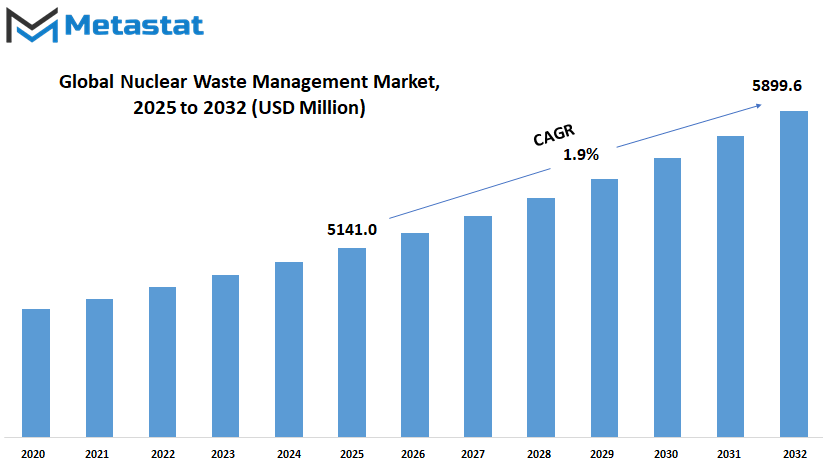
GROWTH FACTORS
Various factors influence the Global Nuclear Waste Management market, curving its trajectory of growth. Understanding these growth factors is essential to understand the dynamics of this market and, more importantly, the factors driving it forward. The growing global demand for energy is a critical factor. As countries move to attain economic growth and industrial development, energy demand increases accordingly. Nuclear energy is an efficient and relatively low-carbon footprint source of energy. The increased reliance on nuclear power, therefore results in the formation of a proportional amount of nuclear waste, hence increasing its management needs.
Additionally, the recognition of nuclear energy as a reliable source with lower greenhouse gas emissions contributes to its increased adoption. As countries commit to reducing their carbon footprint and combatting climate change, nuclear energy becomes a favorable option. The consequential growth in nuclear power generation amplifies the need for efficient waste management practices.
Also, international collaborations and partnerships influence nuclear waste management markets. As energy from nuclear activity is globalized, the country often comes up with collaborative plans to share know-how, material, and expertise in handling radioactive waste. Therefore, international collaborative efforts spur more innovations in various technologies related to waste management as well as influence the overall progress of the nuclear waste management market.
Environmental concerns are one of the most important factors pushing the growth in the nuclear waste management market. With an ever-increasing sense of environmental pollution caused by improperly disposed waste, governments and regulating bodies are becoming more stringent regarding the safe disposal of nuclear wastes. This brings in the demand for the further development and incorporation of advanced nuclear waste management technologies, thus influencing the overall market growth.
The technological advancements in the methods of waste management is another significant growth factor. Continued research and development activities result in the invention of more efficient and sustainable waste management solutions. Inclusion of high-tech technologies further enhances the safety and efficiency in the handling of nuclear waste, thus further pushing the growth in the market.
The increasing number of nuclear power plants across the world is also augmenting the requirement for holistic strategies for waste management. The need for efficient nuclear waste management mechanisms is on the rise with each new nuclear power plant commissioned because of the rise in the production of radioactive wastes during energy production.
The growth in the Global Nuclear Waste Management market lies in a blend of factors. On one hand, the increasing demand for energy keeps pace with environmental considerations, technological upgrading, the growth of the nuclear energy sector, and international cooperation, which jointly push the demand for efficient and sustainable nuclear waste management solutions. Awareness of these growth factors gives priceless enlightenment into the dynamic nature of this developing market.
MARKET SEGMENTATION
By Waste
The Global Nuclear Waste Management market travels through a broad spectrum of different types of waste, each unique in character and implication. Comprehending such types of wastes is basic to understanding the nature of nuclear waste management.
Intermediate Level Waste has a value of 583.6 USD Million in 2022. Intermediate Level Waste falls between High and Low Level Waste in terms of radioactivity. It is made up of materials that require more attention than Low Level Waste but do not approach the intensity of High-Level Waste. The strategies for the effective management of Intermediate Level Waste emphasize both short-term containment and long-term isolation.
High Level Waste 1527.2 USD Million in the year 2022 has been highly radioactive waste resulting from nuclear power operations. Its radicality dictates that its handling and disposal require high technologies to avoid long-term impacts on the environment. Management policy for High Level Waste is, therefore, containment and isolation to prevent adverse impacts on human health and the environment.
The least hazardous materials are Low Level Waste, which stood at 2772.8 USD Million in 2022. These are less radioactive. Though not as potent as High Level Waste, proper disposal remains important to avoid any potential danger. Common items of Low Level Waste include clothing, tools, and reactor components, which are managed with much care to minimize risks.
These types of wastes, High Level, Low Level, and Intermediate Level, together paint a comprehensive picture of the challenges inherent in nuclear waste management. Each type requires specific handling procedures, disposal methods, and regulatory frameworks to ensure the safety of both current and future generations. As we grapple with the complexities of managing nuclear waste, a nuanced understanding of these waste types becomes imperative for devising sustainable and secure solutions.
By Reactor Type
Within the wide canvas of the Global Nuclear Waste Management market, the segmental classification under reactor type captures an aspect that highlights its complex interplay in more depth. Diverse types of reactors add their flavors and repercussions to this market.
With the valuation of 503 USD Million in 2022, The Gas Cooled Reactor serves as another manifestation of nuclear power generation. For its ability to use different coolants, such a reactor finds its place among the tapestry of the market, providing diversions in a complex web for nuclear waste.
Further enhancing this portfolio is the Pressurized Heavy Water Reactor, worth 271.4 USD Million in 2022. Known for its heavy-water characteristics, used as a moderator and coolant, this reactor signifies flexibility within the nuclear energy sector.
The Pressurized Water Reactor is one of the market major players, taking a huge worth of 2885.6 USD Million by the end of 2022. Being of high efficiency with wide usage across the globe makes this reactor of the type play a vital part in nuclear waste generation.
The Boiling Water Reactor segment, valued at 1223.7 USD Million in 2022, adds another dimension to the makeup of the market. With an operational mechanism dissimilar to the pressurized variant, the Boiling Water Reactor adds to the mosaic of diverse technologies used in the nuclear power plant across the globe.
Together, these types of reactors shape the Global Nuclear Waste Management market, each with its own stamp on the problems and solutions in nuclear waste. As the need for clean sources of energy continues to grow, it is necessary to understand the subtleties of each type of reactor to ensure proper management of the resultant nuclear waste and contribute to the sustainability of nuclear energy.
By Disposal Method
The Global Nuclear Waste Management market-a critical area regarding nuclear waste-it unrolls along the various disposition methods that exist in it, such as incineration. All of them serve for quite specific purposes as to how each determines the outcome of nuclear wastes.
There are other methods of disposal, and this gives nuclear waste management diverse approaches. All these methods meet certain criteria that may be associated with the type of waste, environmental implications, and sustainability.
One of the disposal methods is incineration, offering a solution in the controlled burning of waste. It reduces the volume of nuclear waste and the impact on the environment. The other key method is storage, which is a temporary containment of waste. It allows for careful monitoring and assessment before deciding on a more permanent solution.
Deep Geological Disposal is a technique intended for long-term nuclear waste isolation. Burying the waste deep within selected geological formations to minimize the chance of contamination and ensure the safety of surrounding environments is its main objective.
The Global Nuclear Waste Management Market traverses different disposal methods. Each of them represents a distinct approach in dealing with the problems of nuclear waste. Starting from controlled burning to deep burial, such a method points toward the difficulties in disposing of nuclear waste while also depicting the need for holistic and flexible strategy.
|
Forecast Period |
2025-2032 |
|
Market Size in 2025 |
$5141.0 million |
|
Market Size by 2032 |
$5899.6 Million |
|
Growth Rate from 2024 to 2031 |
1.9% |
|
Base Year |
2024 |
|
Regions Covered |
North America, Europe, Asia-Pacific Green, South America, Middle East & Africa |
REGIONAL ANALYSIS
As global nuclear waste management is analyzed, an important area of study focuses on its regional aspect. Market is not a monolithic entity but definitely varies with the geographical factors. Geographically, the market for Nuclear Waste Management provides different patterns and considerations altogether. The regions have diverse challenges as well as opportunities in managing waste. It has to be concisely viewed that the regional dimension has an overwhelming influence on strategies and methods.
With such regional analysis within the Global Nuclear Waste Management Market, it portrays how different aspects of the globe struggle with accomplishing the burden of nuclear waste handling and processing. The whole attitude of all regions toward disposing of nuclear wastes is determined in terms of character, policies, and infrastructures.
The North American region is, therefore, prized for its advanced technological infrastructure and narrow regulatory frameworks, which have recorded heavy investments into devising sophisticated techniques of nuclear waste management in line with the proper commitment towards public safety as well as environmental protection.
Europe's nuclear waste management practice is, on the whole, standardized by collaboration among the member states. The European Union provides a standard framework for rules and regulations on effective and standardized handling of nuclear waste among the member nations.
Asia-Pacific's fast industrialization and energy requirement makes it necessary to scale up nuclear energy and safe waste management. The economy and economic orientation of the Asian countries determine what will be more significant in waste management strategies.
In the Middle East and Africa, where nuclear energy is emerging as part of the energy mix, the focus is on establishing robust waste management protocols from the outset. These regions, though at different stages of nuclear energy utilization, share a common commitment to responsible waste management practices.
South America, with its diverse economic profiles and energy requirements, treads the thin line of realizing nuclear power by keeping pace with the associated complexities about waste management. This makes it a countrywise issue.
Regional analysis is important because nuclear waste management is not a single solution problem. Solutions need to be region-specific because socio-economic, regulatory, and environmental factors vary in each region.
These regional dynamics are key to understanding stakeholders in the Nuclear Waste Management market. It enables them to adjust their strategies so that they may suit the needs of different geographies, thus allowing them to respond to various challenges and opportunities.
The regional analysis of the Global Nuclear Waste Management market unfolds a tapestry of diverse approaches and challenges across different parts of the world. It reinforces the idea that effective nuclear waste management is contingent on acknowledging and adapting to the specific regional contexts in which it unfolds.

COMPETITIVE PLAYERS
In the expansive Global Nuclear Waste Management market, key players play a crucial role in shaping the industry landscape. Among these influential entities are Bechtel Corporation and Augean PLC, both standing as prominent figures in the Nuclear Waste Management sector.
Bechtel Corporation, a stalwart in the industry, brings a wealth of experience and expertise to the table. Renowned for its proficiency in engineering, construction, and project management, Bechtel is a driving force in the nuclear waste sector. The company's commitment to innovation and efficiency positions it as a significant player, contributing to the advancement of nuclear waste management practices.
Augean PLC, another notable player, adds depth to the industry's dynamics. Specializing in waste management services, Augean PLC leverages its capabilities to address the unique challenges posed by nuclear waste. The company's strategic approach and focus on sustainable solutions contribute to the overall efficacy of nuclear waste management initiatives.
These key players exemplify the collaborative efforts and diverse expertise required to navigate the complexities of nuclear waste management. Their roles extend beyond individual accomplishments, encompassing a collective commitment to addressing the challenges associated with nuclear waste on a global scale.
As the Global Nuclear Waste Management market continues to evolve, the influence of key players like Bechtel Corporation and Augean PLC becomes increasingly significant. Their contributions not only shape the present state of nuclear waste management but also pave the way for future advancements in handling and mitigating the impact of nuclear waste on the environment.
Nuclear Waste Management Market Key Segments:
By Waste Type
- High Level Waste
- Low Level Waste
- Intermediate Level Waste
By Reactor Type
- Pressurized Water Reactor
- Boiling Water Reactor
- Gas Cooled Reactor
- Pressurized Heavy Water Reactor
By Disposal Method
- Incineration
- Storage
- Deep Geological Disposal
- Others
Key Global Nuclear Waste Management Industry Players
- Bechtel Corporation
- Augean PLC
- Veolia Environnement SA
- EnergySolutions, Inc.
- Svensk Kärnbränslehantering AB
- Perma-Fix Environmental Services, Inc
- US Ecology, Inc
- Stericycle, Inc
- Waste Control Specialists LLC
- JGC HOLDINGS CORPORATION
WHAT REPORT PROVIDES
- Full in-depth analysis of the parent Industry
- Important changes in market and its dynamics
- Segmentation details of the market
- Former, on-going, and projected market analysis in terms of volume and value
- Assessment of niche industry developments
- Market share analysis
- Key strategies of major players
- Emerging segments and regional growth potential



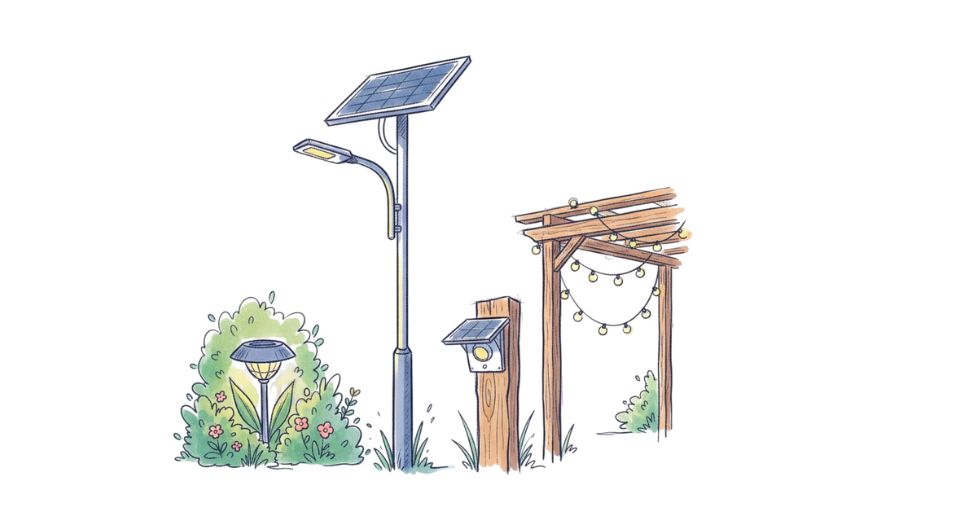
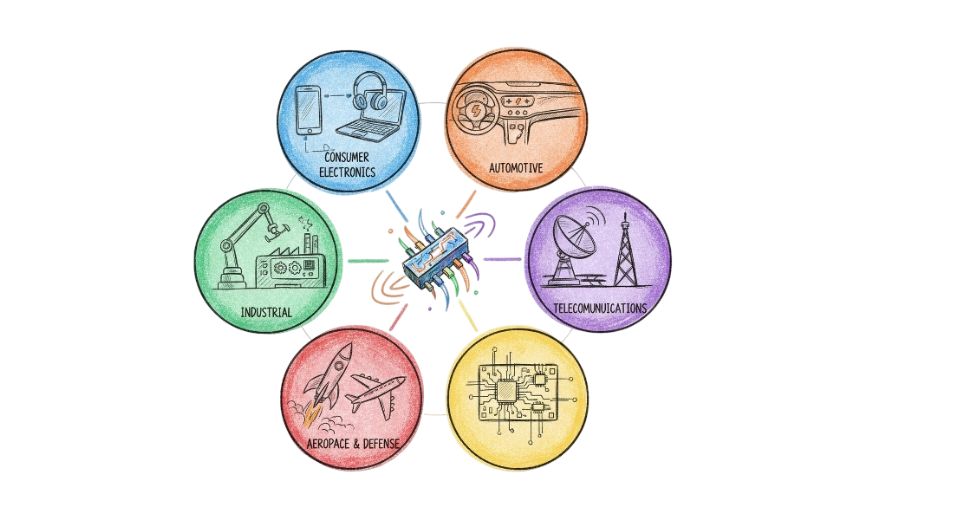
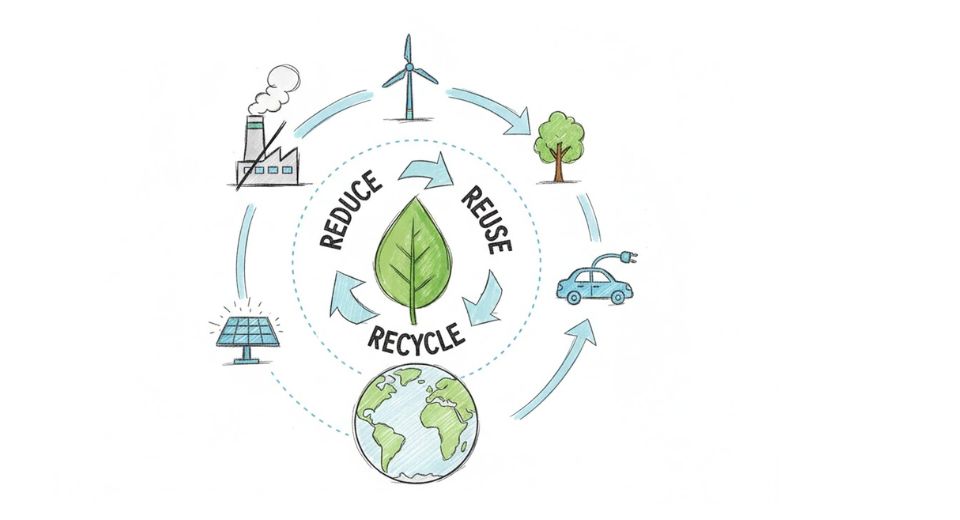
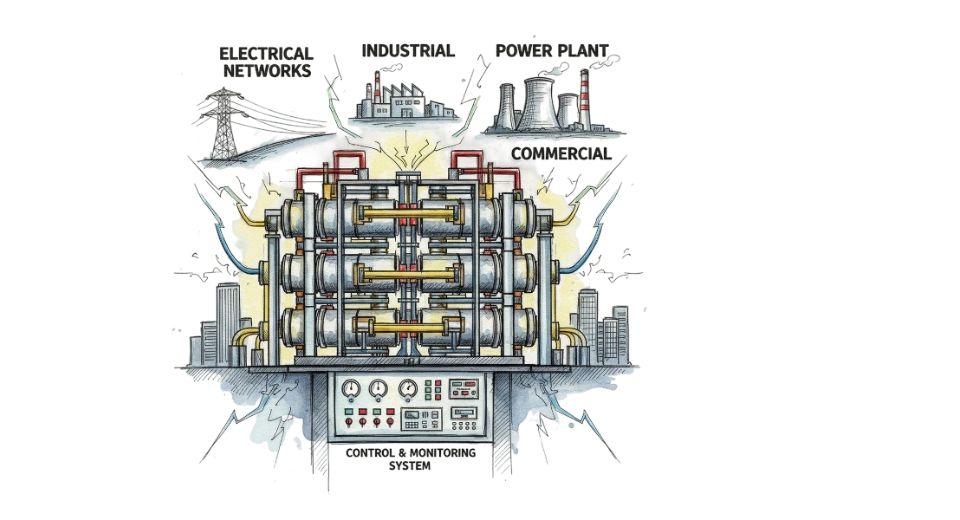

 US: +1 3023308252
US: +1 3023308252






